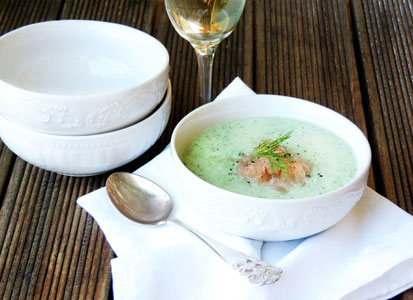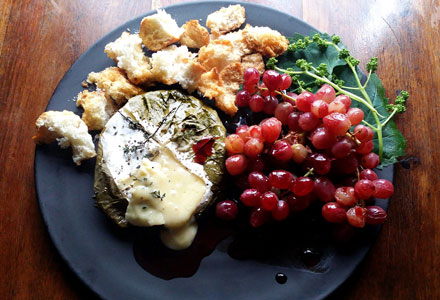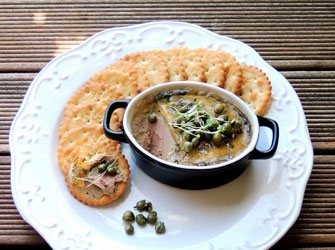Sponsored: Versatile Verjuice
A dash of Verjuice can transform just about any dish – whether it be fish, chicken, venison, vegetables or fruit. Here are three recipes starring Verjuice that proves its culinary worth.
Verjuice, also known as verjus (meaning “green juice” in French), is pressed from green, unripened grapes. The process involves “dropping” unripe clusters of grapes from the vine and takes place midway through the growing process to concentrate energy to the remaining bunches that are destined for making wine. Gently pressed, half-ripened grapes yield a juice that is high in acid and low in sugar.
The acidity and subtle sweetness of Verjuice complements the flavours of a variety of dishes including fish, chicken and meat. It is ideal for deglazing pans for a deliciously rich, reduced syrupy “jus”, which can be diluted with a little stock or water. It also adds flavour complexity to vinaigrettes, dressings, syrups, sauces, gravies and reductions and adds zest to mayos, marinades, pestos and preserves and is perfect for pickling juices for ceviche, onions and vegetables.
Verjuice has a special affinity with nut oils and combines particularly well with walnut and hazelnut oils and emulsifies superbly with groundnut and olive oils. It’s also delicious as a non-alcoholic cordial – simply dilute with still or sparkling water, or enjoy it neat as an apéritif over crushed ice or as a mixer for cocktails and sours.
For more information, visit verjuice.co.za.
TRY THESE DELICIOUS RECIPES STARRING VERJUICE:
Cucumber-and-herb soup with verjuice granita
Serves 4
A cool summer soup with a beautiful pale-green colour, topped with flakes of icy verjuice granita. The contrast of herbal creaminess and sweet, crunchy acidity makes this the perfect starter for a sweltering day. 
For the granita:
verjuice 1⁄2 cup
For the soup:
chilled English cucumbers 2 (about 700 g)
Verjuice 2 T
Greek yoghurt 1 cup
small clove garlic 1, peeled and finely chopped
parsley 1/3 cup chopped
chives 1/3 cup chopped
dill 3 T chopped, plus extra to garnish
Tabasco sauce 1 t
cream 3 T
sea salt and freshly ground black pepper, to taste
1 To make the granita, pour the verjuice into a small metal pan and freeze for 45–60 minutes, or until just frozen. Use a fork to scrape the surface to create light, feathery crystals. Keep in the freezer.
2 Lightly peel the cucumbers, leaving a little green skin here and there. Roughly chop and place in a blender with all the remaining ingredients, except the cream and seasoning. Blend until smooth, then stir in the cream and season to taste with salt and plenty of black pepper.
3 Serve in chilled bowls, topping each with a spoonful of verjuice granita, plus a scattering of dill fronds.
Camembert roasted in vine leaves with verjuice-poached grapes
A gorgeous, jewel-bright starter that combines hot oozing Camembert with sharp-sweet grapes lightly poached in verjuice. If you don’t have fresh vine leaves, use blanched baby spinach leaves to wrap your Camembert. 
Serves 4 as a starter or snack
For the grapes:
verjuice 1 cup
large vine leaves 4 (or 6 baby spinach leaves), stalks removed
honey 1 T
thyme 1 large sprig
sweet red grapes 2 small bunches
just-ripe Camembert 250 g
thyme a sprig
black pepper, to taste
oven-baked croutons or Melba toast, for serving
1 Preheat the oven to 180°C. Pour the verjuice into a shallow pan and bring to a simmer. Spread a large sheet of clingwrap on a work surface. Blanch the vine leaves by dipping each one in the verjuice for 10 seconds. Spread on the clingwrap to dry.
2 Add the honey and thyme to the verjuice, then lay the grapes in the pan on their sides. Poach gently for about 7 minutes, turning often, or until the skin is splitting and fruit is just beginning to collapse. Remove the grapes from the pan and set aside to drain in a colander.
3 Turn up the heat and boil the verjuice until it has reduced by half and is slightly thickened and glossy. Set aside.
4 Cut a cross into the top of the Camembert and push a few thyme leaves into the incisions. Wrap the cheese in the blanched vine leaves, then set it on a sheet of baking paper. Wrap to form a loose parcel and secure with string. Place on a baking sheet and bake at 180°C for 7–10 minutes, or until the cheese feels very soft and oozy.
5 Remove the baking paper and place the cheese on a platter with the poached grapes. Drizzle the verjuice syrup over the grapes and serve immediately with crisp golden croutons or Melba toast.
Chicken liver pâté with verjuice jelly
A delicate liver and thyme pâté topped with a wobbling layer of jellied pale-pink verjuice. The mild, sweet acidity of the jellied verjuice topping contrasts beautifully with the rich flavour of the livers. 
Serves 6–8 as a snack
For the pâté:
chicken livers 500 g
salted butter 120 g
spring onions 6, white and pale green parts only, sliced
fresh thyme 1 large sprig
garlic 1 clove, peeled and finely chopped
verjuice 2 T
cream 3 T
sea salt and freshly ground black pepper, to taste
nutmeg a pinch
For the jelly:
verjuice 1⁄2 cup
powdered gelatine ½ t
crusty fresh bread or crackers, for serving
capers, for serving
1 To make the pâté, trim and rinse the livers, then set aside in a colander. Melt the butter in a large frying pan over a medium heat, add the spring onions and thyme, and cook gently for 3–5 minutes, or until the onions are soft but not browned. Stir in the garlic and cook for a further minute. Increase the heat, add the livers and fry briskly for 3–5 minutes, or until lightly browned on the outside, but still rosy in the middle.
2 Tip the livers and their juices into a blender. Deglaze the pan with the verjuice, stirring and scraping to dislodge any bits. Bubble for 30 seconds, remove the thyme and pour the pan juices into the blender.
3 Blend to a fine, smooth paste, then add the cream, and blend again until just combined. Season to taste with salt, pepper and nutmeg, then pour into a pâté dish (or individual pots) and smooth the top. Cover with clingwrap and chill for 2 hours.
4 To make the jelly, pour the verjuice into a small bowl. Sprinkle over the gelatine and allow to “sponge” for 3 minutes. Set the bowl in a pan of simmering water that comes halfway up the sides and leave until the mixture is clear. Allow to cool for 3 minutes, then pour the jelly over the pâté in an even layer. Sprinkle with thyme leaves and black pepper, then chill until the topping has set.
5 Serve with bread or crackers and capers.


Comments